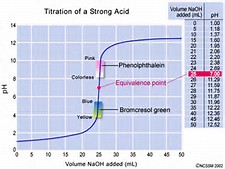How do indicators work?
2 Answers
It is done by putting the indicator in the Acid or Base.
Explanation:
pH indicators detect the presence of
. They do this by reacting with
: they are themselves weak acids and bases. If an indicator is a weak acid and is colored and its conjugate base has a different
color, deprotonation causes a color change.
Well, see this old answer.
Explanation:
An indicator is a large, weak organic acid whose acid and base forms have distinctive colours. And we can represent this species by
The point is that

The graph shows (poorly) the titration curve of a strong acid, when titrated by a strong base. Because the rise in


